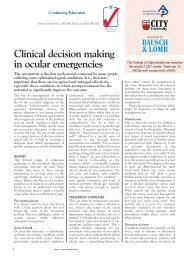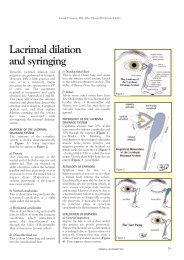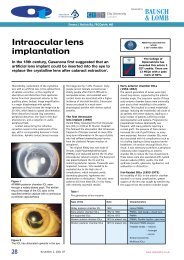You also want an ePaper? Increase the reach of your titles
YUMPU automatically turns print PDFs into web optimized ePapers that Google loves.
CONTINUING EDUCATION AND TRAINING<br />
Gain 2 CET credits - enter online at www.otcet.co.uk or by post<br />
Figure 6 The optic zone sagitta, and consequently, <strong>the</strong> apical clearance, is increased<br />
by steepening <strong>the</strong> BOZR<br />
Figure 7 The optic zone parameters<br />
can be defined according to <strong>the</strong> projection<br />
of <strong>the</strong> optic zone from <strong>the</strong> continuation of<br />
<strong>the</strong> scleral curve measured axially at <strong>the</strong><br />
apex and at <strong>the</strong> limbus<br />
increased settling back with reduction of<br />
<strong>the</strong> optic zone clearance.<br />
There are some comparative advantages<br />
and disadvantages of smaller and larger<br />
lenses. The author’s observation is that <strong>the</strong><br />
scleral topography just outside <strong>the</strong> limbus is<br />
more regular and symmetrical than <strong>the</strong><br />
more peripheral sclera. Smaller diameter<br />
ScCLs may be indicated when a tighter fitting<br />
is necessary. For example, <strong>the</strong>y should<br />
be tried when a non-ventilated 23mm diameter<br />
lens fails to seal well enough on <strong>the</strong><br />
sclera to prevent admission of an air bubble<br />
into <strong>the</strong> pre-corneal reservoir. Bearing on<br />
<strong>the</strong> most symmetrical region of <strong>the</strong> sclera<br />
leads to noticeably less decentration, which<br />
may reduce any prismatic effects.<br />
Smaller lenses can be made thinner than<br />
larger lenses because <strong>the</strong> rigidity is greater<br />
with smaller diameter lenses. The reduced<br />
mass, and less movement on <strong>the</strong> eye compared<br />
to larger lenses, may render a contact<br />
zone more tolerable. Hence <strong>the</strong>y can be fitted<br />
with less corneal clearance, which may<br />
prove to be advantageous if <strong>the</strong> vision is<br />
improved with a visual axis contact zone. A<br />
final advantage of <strong>the</strong> improved centration<br />
and closer proximity to <strong>the</strong> cornea is a more<br />
even depth of <strong>the</strong> pre-corneal fluid reservoir,<br />
this increases <strong>the</strong> possibility that a fenestration<br />
can be more successful than with larger<br />
diameter lenses. However, on <strong>the</strong> downside,<br />
<strong>the</strong> increased tightness of <strong>the</strong> fitting on <strong>the</strong><br />
eye and <strong>the</strong> reduced limbal clearance are significant<br />
drawbacks at times. Although such<br />
lenses are more likely to retain an air-free<br />
pre-corneal reservoir <strong>the</strong>y are more difficult<br />
to insert without a bubble in <strong>the</strong> first place,<br />
and because <strong>the</strong>y fit tighter on <strong>the</strong> eye, <strong>the</strong>y<br />
are distinctly more difficult to remove than<br />
larger diameter lenses.<br />
Optimal scleral zone alignment<br />
The bearing surface should be spread as<br />
evenly as possible over <strong>the</strong> sclera, but with<br />
optic zone clearance. In fact, 13.50mm to<br />
14.50mm is a usual back scleral radius (BSR)<br />
range for most preformed ScCLs. The bearing<br />
surface is displaced away from <strong>the</strong> limbus<br />
if <strong>the</strong> scleral zone is too steep, and may<br />
cause <strong>the</strong> lens to vault as it rests only at <strong>the</strong><br />
periphery, giving an appearance of excessive<br />
apical clearance. A flat fitting scleral zone<br />
shifts <strong>the</strong> bearing surface nearer to <strong>the</strong> limbus,<br />
but does not appreciably affect <strong>the</strong> apical<br />
clearance. Figure 3 diagrammatically<br />
illustrates scleral zone alignment and<br />
corneal clearance. Figures 4 and 5 are fluorescein<br />
photographs showing a steep and<br />
flat fitting scleral zone respectively.<br />
A glove fit on <strong>the</strong> sclera is not possible,<br />
nor essential, but <strong>the</strong> scleral zone needs to<br />
be sufficiently sealed to prevent <strong>the</strong> introduction<br />
of air bubbles into <strong>the</strong> pre-corneal<br />
fluid reservoir. An overall view of <strong>the</strong> scleral<br />
zone with a hand-held low magnification<br />
lamp is sufficient to see <strong>the</strong> extent of <strong>the</strong><br />
clearance beyond <strong>the</strong> limbus. Any areas of<br />
conjunctival blood vessel blanching, which<br />
are due to localised compression while <strong>the</strong><br />
lens is in situ, can be seen simultaneously<br />
with a white light source.<br />
Corneal and limbal clearance<br />
Achieving optimal clearance at <strong>the</strong> limbus<br />
and at <strong>the</strong> apex is determined by varying <strong>the</strong><br />
back optic zone radius (BOZR) and <strong>the</strong> back<br />
optic zone diameter (BOZD) in combination<br />
to give <strong>the</strong> optic zone sagitta (OZS). Varying<br />
<strong>the</strong> BOZR with a constant BOZD gives rise to<br />
a precisely calculable change to <strong>the</strong> central<br />
corneal clearance, as in Figure 6, but varying<br />
<strong>the</strong> BOZD with a constant BOZR does not<br />
because <strong>the</strong> curvature of <strong>the</strong> scleral bearing<br />
surface is an unknown quantity. This is <strong>the</strong><br />
same principle as traditional style PMMA<br />
ScCL fitting, but most modern fitting<br />
systems utilising <strong>the</strong> OZS principle calculate<br />
<strong>the</strong> combined specifications to give significant<br />
variations in apical and limbal<br />
clearance, <strong>the</strong>refore it is not necessary for<br />
<strong>the</strong> practitioner to try combinations of<br />
BOZRs and BOZDs.<br />
The corneal clearance can also be varied<br />
by changing <strong>the</strong> optic zone projection (OZP)<br />
in progressive increments but without reference<br />
to <strong>the</strong> BOZR or BOZD. Figure 7 illustrates<br />
OZP diagrammatically. The optic zone<br />
Figure 8 Off-axis apical contact zone in<br />
an advanced keratoconus wearing a nonventilated<br />
RGP scleral lens. This amount of<br />
contact was tolerated by <strong>the</strong> wearer and<br />
did not lead to any corneal erosion<br />
30 | October 20 | 2006 | OT
















